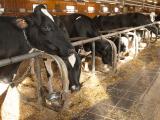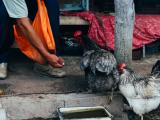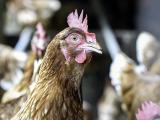Apr 17, 2013 (CIDRAP News) – The number of people infected with H7N9 influenza in China grew by five today, with Shanghai and Zhejiang province reporting fresh cases, and news reports described an H7N9 family cluster apparently linked to one of the outbreak's first confirmed cases.
The five new cases announced today are all in adults. Three are seniors, two are younger adults, and all are hospitalized, according to official and media sources.
The family cluster of infections is reportedly connected to an 87-year-old man from Shanghai whose illness and death were announced on Mar 31 when China first revealed the detection of the novel virus and the first three known human cases. At the time, media reports said two of his sons, ages 55 and 69, were hospitalized with similar symptoms at about the same time in late February, but local officials had said neither had the virus.
A news report today from China Daily, citing the Chinese National Health and Family Planning Commission, said an H7N9 infection was confirmed in the older son, who recovered, but results on the younger son, who died, were not available.
Another report from Xinhua today, citing the same source, said the man and his two sons all had H7N9 infections. The Xinhua report also said officials from the China Center for Disease Control and Prevention (China CDC) have not determined if the man and his sons were exposed to the virus from infected poultry, a contaminated environment, or from other infected people.
Shanghai's health bureau yesterday reported five retrospective lab-confirmed H7N9 cases, but it's not clear if either of the two sons is included in that group, and the WHO and other official organizations have not detailed or confirmed any connection between any of those cases and the family cluster described in the news stories.
If confirmed by official sources, the cases would be the second instance of family-contact infections in China's H7N9 outbreak. The other one involved a wife and husband in Shanghai. The 52-year-old woman died from her infection on Apr 3, and on Apr 13 Chinese officials said they had detected the virus in her 56-year-old husband.
Family clusters of infections aren't surprising and can result from common-source exposures or from human-to-human contact. Thorough investigations are needed to confirm human transmission. Health officials have said they expect some limited human-to-human spread as the H7N9 outbreak unfolds. Several similar instances have been documented with the H5N1 virus.
Close-contact infections among family members don't represent the type of ongoing, sustained human-to-human that would signal a pandemic threat.
Among the newly reported cases today from Zhejiang province are a 37-year-old woman and three men, ages 41, 74, and 86, according to a report today from Hong Kong's Centre for Health Protection. Their illness-onset dates range from Apr 8 to Apr 14.
All four of the patients are hospitalized, and all except for the younger man are in critical condition, Xinhua, China's state news agency reported today.
The fifth new H7N9 case reported today is in an 89-year-old man from Shanghai, according to the CHP report. He is hospitalized in stable condition, Xinhua reported.
The World Health Organization (WHO) today included all of the new cases reported yesterday and today in its official total, which is 82 infections and 17 deaths. (The WHO's total does not include the asymptomatic case announced last weekend.) The update appears to include one more death in an earlier reported case, but it's not clear which one.
Official and news reports of today's new cases contained few details about how the patients may have been exposed to the virus. A report from the Zhejiang province health bureau, translated and posted by FluTrackers, an infectious disease message board, said the 37-year-old woman is a farmer.
Dr. Zeng Guang, chief epidemiologist at the China CDC, told the Beijing News that about 40% of the H7N9 patients had no clear history of exposure to poultry, Reuters reported today. Gregory Hartl, a spokesman for the WHO, said on Twitter today that there are some lab-confirmed cases that had no history of contact with poultry, which builds the case for a wide investigation net.
Meanwhile, influenza experts suspect that poultry or contact with poultry environments, such as live-bird markets, is a likely source of the virus, but the exact source or sources remains a puzzling aspect of the outbreak. Because the virus has low pathogenicity in birds, birds and poultry aren't visibly ill or dead, which often provides a vital clue in H5N1 avian flu outbreaks.
New information on poultry and bird surveillance from China's agriculture ministry today shed little new light on how humans are becoming infected Of 47,801 samples from more than 1,000 poultry markets, habitats, farms, and slaughterhouses across the country, only 39 samples were positive for the virus, according to a report from Xinhua, which quoted an agriculture ministry statement.
Of the 39 positive samples, 38 were from live-poultry markets in the areas where most of the human cases have been reported: the city of Shanghai, plus Jiangsu, Zhejiang, and Anhui provinces.
The other sample that yielded the virus was from a wild pigeon in Jiangsu province. That detection was noted in a report yesterday from the World Organization for Animal Health (OIE).
See also:
Apr 17 CHP statement
Apr 18 China Daily story
Apr 18 Xinhua story on family cluster
Apr 17 WHO update
Apr 17 Xinhua report on family cluster
Apr 17 Xinhua report on new Zhejiang cases
Apr 17 Xinhua report on new Shanghai case
FluTrackers thread
Apr 17 Reuters story
Apr 17 Xinhua story on poultry sampling


















